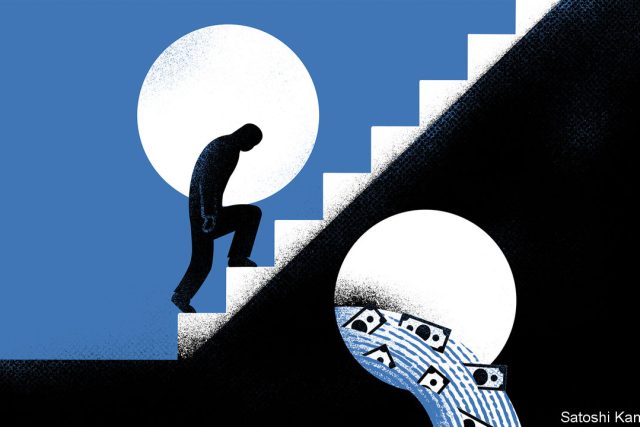The past three months have afforded investors little pause for thought. Since a run on Silicon Valley Bank (svb) in March, markets have had to judge first whether one American lender would collapse (yes), then others (yes, though mercifully few), then whether the contagion would spread overseas (just to Credit Suisse). With the takeover of First Republic, another regional lender, on May 1st, bank failures seemed to have petered out. But by then it was time to worry about whether America’s politicians would throw global markets into chaos by defaulting on their sovereign debt. As this column was published, they at last appeared to have decided not to, provided a deal between President Joe Biden and Kevin McCarthy, the Republican speaker of the House of Representatives, makes it through Congress.
All this drama has given markets a holiday of sorts: it offered a break from obsessing about how high interest rates will need to rise to quash inflation. Since the Federal Reserve started hoisting borrowing costs in March last year, little has mattered more to investors. But after svb’s fall, the question was not how much the Fed was prepared to do to fight inflation; it was how much it might need to do to stabilise the financial system.
Now attention is turning back to interest rates. Once again, they are on the rise. In early May the yield on two-year Treasuries, which is especially sensitive to expectations of the Fed’s policy rate, fell to 3.75%. It has since increased to 4.4% as officials briefed journalists they were contemplating raising rates further than their present level of 5-5.25%. Traders in futures linked to interest rates, who were until recently anticipating rate cuts within months, have also switched to betting on another rise.
The new mood music can be heard outside America as well. In Britain former rate-setters have warned that the Bank of England’s benchmark rate may rise to 6% from its current 4.5%. Yields on government bonds have climbed to within touching distance of levels last September, which at the time were only reached amid fire sales and a market meltdown.
For Jerome Powell, the Fed’s chairman, this may come as a relief. In early March he appeared to have convinced investors that the central bank was serious about lifting interest rates and keeping them high. He and his colleagues had spent months saying so; traders had spent months trying to call their bluff. But then something in the market’s psyche snapped, and investors at last priced in the same path for rates as the Fed. Days later banking turmoil broke out and they abandoned the bets as fast as depositors fled svb. That the market has now realigned itself with the Fed’s view of the world counts as a win for monetary guardians.
The return of rising rates feels more ominous for investors. True, part of the story is that the economy has held up better than expected at the start of the year, and certainly better than feared once banks began to buckle. Yet the bigger part of the story is that inflation has proved unexpectedly stubborn. As of April “core” American prices, which exclude food and energy, were 5.5% higher than a year ago. Although recession has been avoided or delayed, few are predicting stellar growth. In these circumstances, rising rates are bad for stocks and bonds. They hurt share prices by raising firms’ borrowing costs and marking down the present value of future earnings. Meanwhile, bond prices are forced down to align their yields with those prevailing in the market.
Does this mean another 2022-style crash? Certainly not in the bond market. Last year the Fed lifted rates by more than four percentage points. An extra quarter-point rise or two this year would have nothing like the same effect.
Shares, though, look vulnerable on two counts. One is that most of the stockmarket ran out of momentum some time ago. The s&p 500 index of large American firms has risen by 10% this year, but the entire increase is down to its biggest seven tech stocks, all of which seem gripped by ai euphoria. Such a narrowly led, sentiment-based climb could easily be reversed. The second source of market vulnerability is the earnings yield, which offers a quick-and-dirty guide to potential returns. The s&p 500’s is 5.3%. This means stockholders are taking the risk of owning equities for an expected return that the Fed may shortly be offering risk-free. Stay tuned for more drama.■
Read more from Buttonwood, our columnist on financial markets:
The American credit cycle is at a dangerous point (May 24th)
How to invest in artificial intelligence (May 17th)
Investors brace for a painful crash into America’s debt ceiling (May 10th)
Also: How the Buttonwood column got its name




The Most Read
Сryptocurrencies
Bitcoin and Altcoins Trading Near Make-or-Break Levels
Financial crimes
Thieves targeted crypto execs and threatened their families in wide-ranging scheme
Financial crimes
Visa Warning: Hackers Ramp Up Card Stealing Attacks At Gas Stations
News
Capitalism is having an identity crisis – but it is still the best system
Uncategorized
The 73-year-old Vietnamese refugee is responsible for bringing Sriracha to American consumers
Uncategorized
Electric Truckmaker Rivian, Backed By Amazon, Ford, Raises Whopping $1.3 Billion